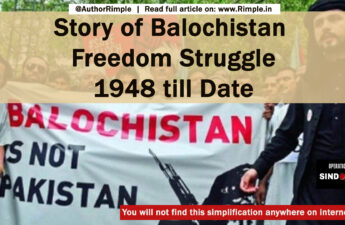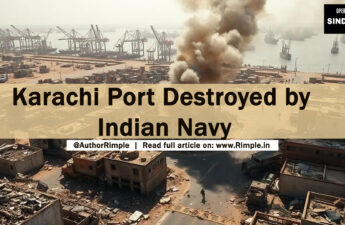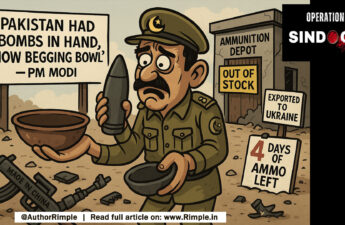The Balochistan freedom struggle, a decades-long battle against Pakistan’s oppression, has reached a boiling point since the April 22, 2025, Pahalgam attack in Indian-administered Kashmir. This brutal attack, which killed 26 civilians, mostly Hindu tourists, was blamed on Pakistan-backed militants. While Pakistan denied involvement, the Baloch freedom fighters seized the moment to escalate their fight, launching a series of daring attacks against the Pakistani military. From burning military trucks to occupying highways, their actions have shaken Pakistan’s grip on Balochistan. They’ve also openly supported India, seeking its diplomatic backing and even an embassy in New Delhi. Indian leaders, like National Security Advisor Ajit Doval, have warned Pakistan of severe consequences, while Baloch leaders like Mir Yar Baloch dream of UN recognition for an independent Balochistan. This article chronicles every major activity by Baloch freedom fighters from April 22 to May 9, 2025, celebrates their support for India, and mocks Pakistan’s crumbling control—a historic win for Balochistan and India, and a humiliating loss for Pakistan.
Balochistan’s Fight Intensifies: A Timeline of Actions (April 22–May 9, 2025)
The Balochistan Liberation Army (BLA), the spearhead of the freedom movement, has unleashed a wave of attacks since the Pahalgam attack, targeting Pakistan’s military to expose its weakness and rally global support. Below is a date-by-date account of their actions, with impacts on Pakistan and its army, all in simple language.
April 24, 2025: Triple Attacks in Zamuran, Kolwah, and Kalat
Action 1: BLA freedom fighters struck Pakistani military targets in three separate attacks across Balochistan. In Zamuran, Kolwah, and Kalat, they used remote-controlled improvised explosive devices (IEDs) and armed assaults to hit army patrols. The BLA announced these attacks as a direct response to Pakistan’s “occupation” and its alleged role in regional terrorism, including the Pahalgam attack. They also expressed solidarity with India, condemning Pakistan’s “terrorist tactics” in Kashmir.
Impact 1: Seven Pakistani soldiers were killed, and several vehicles were damaged. The attacks disrupted military operations in these areas, forcing Pakistan to divert troops to secure remote outposts. The BLA’s public statement supporting India embarrassed Pakistan internationally, as it highlighted Balochistan’s unrest amid Pakistan’s denials of sponsoring terrorism.
April 25, 2025: Ambush Near Quetta and Highway Checkpoints
Action 2: In Margat, near Quetta, BLA fighters detonated a remote-controlled IED, obliterating a Pakistani Army convoy. They claimed to have destroyed one military vehicle and killed 10 soldiers, releasing a video to prove their success. The BLA warned of “massive attacks” to come. On the same day, fighters set up checkpoints on highways around Quetta, briefly controlling key routes and checking vehicles to assert their authority. They reiterated their support for India, accusing Pakistan of “diverting attention from Balochistan’s plight” with the Pahalgam attack.
Impact 2: The ambush killed 10 soldiers and destroyed a military truck, depleting Pakistan’s resources in the provincial capital. The highway checkpoints paralyzed transport, scaring traders and exposing Pakistan’s inability to secure even urban areas. The BLA’s video went viral, boosting morale among Baloch supporters and shaming Pakistan’s army, which struggled to respond. Pakistan’s narrative of “stability” in Balochistan crumbled as global media picked up the story.
April 28, 2025: ISI Agent Killed, Multiple Targets Hit
Action 3: In Pasni, BLA fighters assassinated an agent of Pakistan’s Inter-Services Intelligence (ISI), accusing him of spying on Baloch activists. In three other operations across Balochistan, they targeted Pakistani army vehicles, a police convoy, and a Chinese-run Saindak Project site, using IEDs and gunfire. The BLA declared these attacks a message to Pakistan and its “foreign backers” like China, while praising India’s stance against Pakistan-sponsored terrorism.
Impact 3: The ISI agent’s killing disrupted Pakistan’s intelligence network, weakening its ability to track Baloch fighters. The attacks damaged two army vehicles, one police truck, and infrastructure at the Saindak Project, costing Pakistan millions in repairs and lost production. At least five soldiers and two policemen were wounded, further straining military morale. The BLA’s pro-India statement fueled Pakistan’s paranoia about Indian support, diverting its focus from counterinsurgency.
April 30, 2025: Massive Assault and Highway Seizures
Action 4: In a stunning escalation, the BLA claimed to have killed over 40 Pakistani soldiers in coordinated attacks across Balochistan. They used a mix of ambushes, IEDs, and sniper fire to target military outposts in Turbat, Panjgur, and Mach. Fighters also seized several highways, setting up checkpoints and blocking military convoys for hours. The BLA announced, “We stand with India against Pakistan’s terrorism,” linking their fight to the broader regional struggle against Pakistan’s military.
Impact 4: The attacks killed at least 40 soldiers, one of the deadliest days for Pakistan’s army in Balochistan. Multiple vehicles, weapons caches, and outposts were destroyed, costing millions and exposing Pakistan’s overstretched forces. The highway seizures halted trade and military logistics, with Quetta cut off for nearly a day. Pakistan’s government faced public outrage, and the army’s failure to retake highways quickly proved its “control” was a myth. The BLA’s pro-India stance amplified calls for international scrutiny of Pakistan’s actions.
May 6, 2025: Bomb Attack Kills Seven Soldiers
Action 5: A powerful bomb attack in an unspecified part of Balochistan killed seven Pakistani troops and wounded five. The BLA claimed responsibility, calling it a “warning to Pakistan’s mercenary army.” They again voiced support for India, praising its “resolve” against Pakistan’s terrorism and urging India to back Balochistan’s independence.
Impact 5: The attack killed seven soldiers and injured five, further depleting Pakistan’s forces. The loss of personnel and equipment strained military operations, with hospitals in Quetta overwhelmed. Pakistan’s government downplayed the attack, but the BLA’s statement supporting India drew global attention, embarrassing Pakistan as it faced criticism over the Pahalgam attack.
May 8, 2025: Twin IED Attacks in Bolan and Kech
Action 6: The BLA launched two devastating IED attacks in Balochistan’s Bolan and Kech regions, targeting Pakistani military units. In Bolan, a military truck carrying soldiers was destroyed, killing 12 personnel, including senior officers. In Kech’s Kulag Tigran area, a remote-controlled IED hit a Bomb Disposal Squad, killing two soldiers during a clearance mission. BLA spokesperson Jeeyand Baloch declared, “The Pakistani army is a mercenary gang thriving on Chinese money. Our attacks will intensify.” The BLA also praised India’s Operation Sindoor, which struck Pakistan’s terror camps on May 7, calling it “justice for Pahalgam.”
Impact 6: The twin attacks killed 14 soldiers, including high-ranking officers, and destroyed a military truck and bomb disposal equipment. The loss of senior personnel disrupted command structures, while the destruction of assets cost millions. Pakistan’s army rushed reinforcements to Bolan and Kech, diverting resources from other fronts. The BLA’s endorsement of India’s Operation Sindoor infuriated Pakistan, which accused India of fueling Baloch unrest, though no evidence was provided.
May 8, 2025: Attack on Dera Bugti Gas Fields
Action 7: BLA fighters attacked Pakistan’s gas fields in Dera Bugti, a critical energy hub with over 100 gas wells. The assault damaged infrastructure and halted production for hours. Mir Yar Baloch, a prominent Baloch writer and activist, announced the attack, claiming it was part of their push for independence. He also expressed solidarity with India, thanking it for exposing Pakistan’s “terrorist face” through Operation Sindoor.
Impact 7: The attack disrupted gas production, costing Pakistan millions in revenue and forcing emergency repairs. The military deployed additional troops to guard energy sites, stretching its forces thinner. The BLA’s pro-India stance, amplified by Mir Yar Baloch’s posts, increased diplomatic pressure on Pakistan, as global media highlighted Balochistan’s unrest alongside the India-Pakistan tensions.
Indian Leaders Back Balochistan: Statements and Posts
Indian officials have seized the moment to criticize Pakistan’s actions in Balochistan, warning of consequences and indirectly supporting the Baloch struggle. Below are key statements and posts since April 22, 2025.
Ajit Doval, National Security Advisor
- May 7, 2025: After India’s Operation Sindoor struck terror camps in Pakistan and Pakistan-occupied Kashmir (PoK), Ajit Doval briefed global leaders, including U.S. Secretary of State Marco Rubio. He said, “India has no intent sorescalate, but if Pakistan tries anything else, it risks losing Balochistan forever. Their army can’t hold it together.” Doval emphasized that Pakistan’s support for terrorism, like the Pahalgam attack, is backfiring by fueling rebellions like Balochistan’s.
- May 8, 2025: Doval reiterated, “Pakistan’s military is crumbling under Baloch attacks. If they don’t stop their terrorist games, Balochistan will slip from their hands.” He praised the Baloch for exposing Pakistan’s “fake control” and hinted at India’s readiness to support their cause diplomatically.
Vikram Misri, Foreign Secretary
May 8, 2025: Misri declared, “Pakistan escalated tensions with the Pahalgam attack, and now it faces the consequences in Balochistan. The choice to de-escalate is theirs, but their army’s brutality is uniting the Baloch against them.” He indirectly praised the BLA’s resilience, noting that Pakistan’s “own actions are carving Balochistan away.”
Indian Army’s Official Account (@adgpi)
May 6, 2025: The Indian Army posted on X, “#PahalgamTerrorAttack Justice is Served. Jai Hind!” This celebrated Operation Sindoor and resonated with Baloch fighters, who saw it as a nod to their shared fight against Pakistan’s military.
S.P. Vaid (@spvaid), Former Jammu & Kashmir DGP
May 8, 2025: S.P. Vaid, a retired Indian police officer, posted on X, “To the people of Balochistan: The time has come to claim your freedom. As we bring an end to Pakistan, rise up, strike, and take what is rightfully yours.” This bold call to action electrified Baloch activists, who shared it widely as proof of India’s support.
These statements show India’s growing willingness to back Balochistan’s cause, not just to counter Pakistan’s terrorism but to expose its internal collapse. Doval’s warnings and Vaid’s post have inspired Baloch fighters, who see India as their biggest ally.
Mir Yar Baloch’s Vision: UN Recognition and an Embassy in India
On May 8, 2025, Mir Yar Baloch, a leading Baloch writer and activist, made a historic announcement that captured the world’s attention. In a series of posts on X, he declared Balochistan’s independence from Pakistan and outlined bold demands:
- Independence Declaration: “A possible announcement soon should be done as the collapse of the terrorist Pakistan is near. We have claimed our independence.” Mir Yar Baloch claimed that Baloch freedom fighters, led by the BLA, had weakened Pakistan’s army to the point of no return. He predicted that the United Nations (UN) would soon recognize Balochistan as a separate country, citing the province’s “liberation war” and global support.
- Request for a Baloch Embassy in India: “We request India to allow Balochistan’s official office and embassy in Delhi.” This was a direct appeal to India, seen as a friendly nation, to formalize diplomatic ties with a future Baloch state. The request thrilled Baloch activists, who see India as a key ally against Pakistan.
- UN Peacekeepers and Pakistani Withdrawal: “We urge the UN to immediately send its peacekeeping missions in Balochistan and ask Pakistan’s occupational army to vacate the territories, air space, and sea of Balochistan and leave all the weapons and property in Balochistan.” This demand framed Pakistan as an occupying force, aligning with the BLA’s narrative of resistance.
On May 9, 2025, Mir Yar Baloch announced a “state ceremony of the independence government of Balochistan” to be held soon, inviting “friendly countries” like India to attend. He claimed that Baloch fighters were now engaged in “street battles” with Pakistani forces, signaling a full-scale uprising.
These declarations have galvanized the Baloch movement, with activists like Hyrbyair Marri and Jeeyand Baloch echoing Mir Yar Baloch’s call for independence. The BLA’s attacks, paired with these bold statements, have put Pakistan on the defensive, scrambling to dismiss Balochistan’s push as “foreign propaganda.”
Pakistan: Sandwiched, Shamed, and Sinking
Pakistan is now a laughingstock, caught in a trap of its own making. On one side, India’s Operation Sindoor has crushed its terror camps, proving its military can strike at will. On the other, Baloch freedom fighters are burning its trucks, blasting its soldiers, and seizing its highways. Pakistan’s army, once feared, is a punching bag—losing 78 soldiers, dozens of vehicles, and millions in assets in just two weeks (April 24–May 8, 2025). Its gas fields are under attack, its economy is bleeding, and its lies about “controlling Balochistan” are exposed.
The Baloch struggle, born in 1948 when Pakistan betrayed the Khan of Kalat, is finally bearing fruit. The BLA’s relentless attacks, from Quetta to Dera Bugti, show a people ready to break free. Their support for India—calling Operation Sindoor “justice” and begging for an embassy—has humiliated Pakistan, which can’t stop its own province from aligning with its arch-enemy. Former Pakistani PM Shahid Khaqan Abbasi admitted on May 6 that the army loses control of Balochistan “after dark,” with BLA fighters patrolling highways like they own them.
India, meanwhile, is soaring. Operation Sindoor, backed by Ajit Doval’s steely resolve, has shown the world that Pakistan’s terrorism will face consequences. Doval’s warning—if Pakistan doesn’t stop, Balochistan will be free—has Pakistan trembling. S.P. Vaid’s post, urging Baloch to “rise up,” is a battle cry that echoes across the border. India’s diplomatic outreach, briefing global powers like the U.S., has isolated Pakistan, while its markets stay strong despite the tensions.
The UN may soon heed Mir Yar Baloch’s call. With Pakistan’s army crumbling and Baloch fighters gaining ground, recognition of an independent Balochistan feels closer than ever. This would be a massive win for the Baloch, who’ve fought for 77 years against Pakistan’s greed, brutality, and lies. It’s a triumph for India, which has stood by the Baloch, exposing Pakistan’s terrorist face while securing its own borders. And for Pakistan? It’s a catastrophic loss—a nation that stole Balochistan’s gas, crushed its culture, and killed its people is now watching its empire collapse. Pakistan is a big-time loser, sandwiched between India’s might and Balochistan’s courage, mocked by the world as its dreams of dominance turn to dust.
Also Read:





